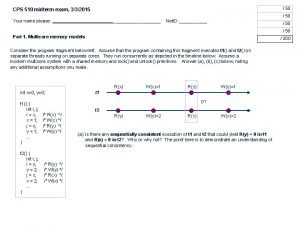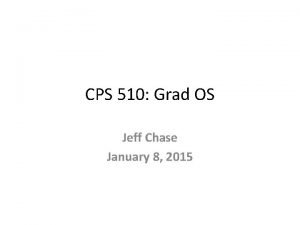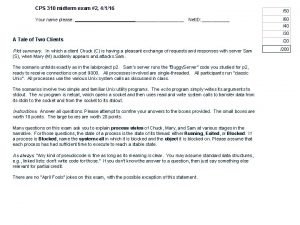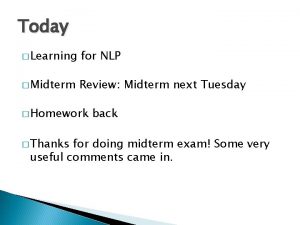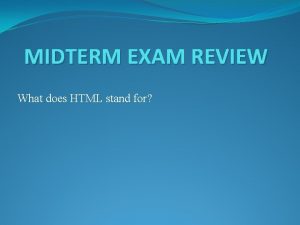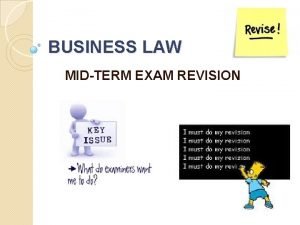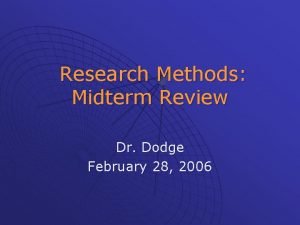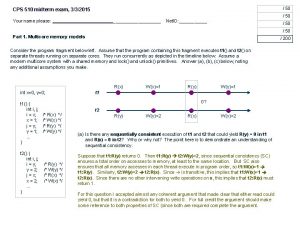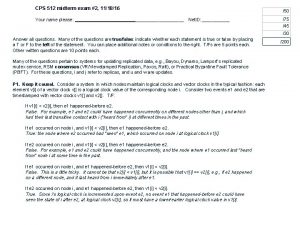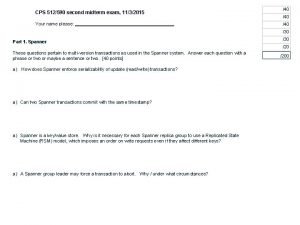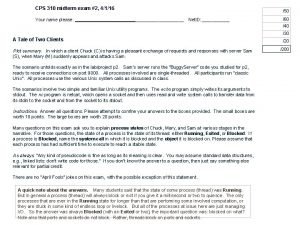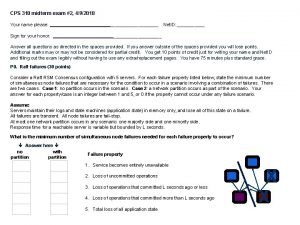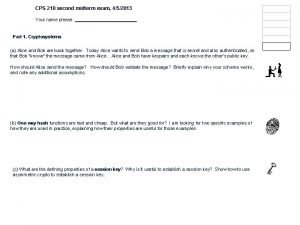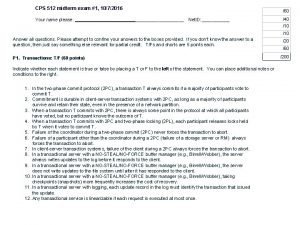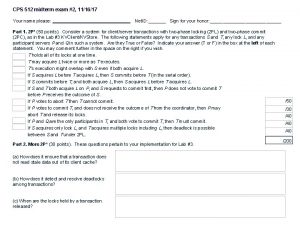50 CPS 510 midterm exam 332015 Your name










- Slides: 10

/ 50 CPS 510 midterm exam, 3/3/2015 Your name please: __________ / 50 Net. ID: ______ / 50 Part 1. Multicore memory models / 200 Consider the program fragment below left. Assume that the program containing this fragment executes t 1() and t 2() on separate threads running on separate cores. They run concurrently as depicted in the timeline below. Assume a modern multicore system with a shared memory and lock() and unlock() primitives. Answer (a), (b), (c) below, noting any additional assumptions you make. R(x) int x=0, y=0; W(x)=1 R(y) W(y)=1 t 1 0? t 1() { int i, j; i = x; x = 1; j = y; y = 1; … } /* R(x) */ /* W(x) */ /* R(y) */ /* W(y) */ t 2() { int i, j; i = y; y = 2; j = x; x = 2; … } /* R(y) */ /* W(y) */ /* R(x) */ /* W(x) */ t 2 R(y) W(y)=2 R(x) W(x)=2 (a) Is there any sequentially consistent execution of t 1 and t 2 that could yield R(y) = 0 in t 1 and R(x) = 0 in t 2? Why or why not? The point here is to demonstrate an understanding of sequential consistency.

CPS 510 midterm exam, 3/3/2015, page 2 of 10 Part 1. (Continued) (b) Annotate the timeline below to show to use locks to ensure a sequentially consistent execution with respect to the operations on x and y. R(x) W(x)=1 R(y) W(y)=2 R(x) W(x)=2 t 1 t 2 (c) How many possible synchronization orders exist for the example above? Pick one and illustrate it on the timeline above by drawing arrows for the happened-before relationships. If you prefer you may illustrate it on the timeline below. R(x) W(x)=1 R(y) W(y)=2 R(x) W(x)=2 t 1 t 2

CPS 510 midterm exam, 3/3/2015, page 3 of 10 Part 2. Threads and concurrency control This problem asks you to write the core of a program to issue and service disk requests. As always: “Any kind of pseudocode is fine as long as its meaning is clear. You may assume standard data structures, e. g. , linked lists: don’t write code for those. ” There are N requester threads that issue requests and one servicer thread to service the requests. Requesters issue requests by placing request objects on a queue. The queue is bounded to at most MAX requests: a requester waits if the queue is full. Each requester is permitted to have at most one pending request. The servicer handles requests only when the queue is full or all living requesters have a pending request. Write procedures for the requesters and servicer. You will need to use some control concurrency: use monitors, mutexes, condition variables, and/or semaphores (your choice). int N, MAX; Queue rq; /* global pre-initialized constants */ /* a queue with put/get operations */ /* Code for the servicer thread */ void servicer() { /* Requester threads call this for each request */ void request(Request. Object robj) { } }

CPS 510 midterm exam, 3/3/2015, page 4 of 10 Part 3. CPU protection and OS structure In a Dune-enabled Linux system, as described in the Dune paper, the various pieces of software run in one of four different CPU protection levels (states) depicted in the diagram below. This part asks several questions relating to this system and diagram. (a) Annotate the diagram with words or phrases to indicate what kind of software runs in each of the four states, and why: what are the advantages of each state as a context to run that software? host user guest user mode kernel mode host kernel guest kernel host mode (VMX root) guest mode (VMX non-root)

CPS 510 midterm exam, 3/3/2015, page 5 of 10 Part 3. CPU protection and OS structure (continued) (b) Now annotate the diagram again to indicate transitions (i. e. , control transfers) between states that occur in the system as it runs. Add words or phrases to label those transitions and indicate what kind of events trigger those state transitions. host user guest user mode kernel mode host kernel guest kernel host mode (VMX root) guest mode (VMX non-root)

CPS 510 midterm exam, 3/3/2015, page 6 of 10 Part 3. CPU protection and OS structure (continued) (c) Software running in each of the four CPU protection states runs within a virtual address space (VAS) defined by page table maps stored in memory. Annotate the figure again as follows. First, for each of the four states, indicate how many VASs use that state (e. g. , 0, 1, N), and what events cause the creation and destruction of a VAS for that state. Second, for each state, draw arrows to the other state(s) whose software sets up and maintains the page tables for those VASs. host user guest user mode kernel mode host kernel guest kernel host mode (VMX root) guest mode (VMX non-root)

CPS 510 midterm exam, 3/3/2015, page 7 of 10 Part 4. Library OS Please keep answers short and direct. “Answers are graded on content, not style. ” It is not necessary to write essays with complete sentences: use lists, phrases, or whatever is easy and expressive. Please do not restate any part of the question. The paper on the Drawbridge library OS mentions that previous library OS systems (e. g. , Exokernel) focus on “providing applications with fine-grained, customized control of hardware resources, such as page tables, network packets, and disk blocks. ” We also discussed how Scheduler Activations uses this concept to enable a high-performance thread system as a library (“ULTS”): the userlevel thread library and kernel interact to allocate CPU cores (“processors”) to the application. (a) Summarize what events might cause an application to gain or lose a processor core in a Scheduler Activations system. How does the thread library learn of changes in the number of cores allocated to the application?

CPS 510 midterm exam, 3/3/2015, page 8 of 10 Part 4. Library OS (continued) Drawbridge, the paper says, has “differing goals (security, host independence, and migration)”, and therefore its design differs from Exokernel and other library OS systems that emphasized per-application control over raw hardware resources. Instead, its focus is to offer “higher-level abstractions” that “make it easier to share underlying host OS resources such as buffer caches, file systems, and networking stacks with the library OS”. In particular, Drawbridge applications can “share resources including the screen, keyboard, and mouse”. (b) Discuss how Dune balances these apparently competing sets of goals. How does Dune’s design exemplify each of these structuring philosophies? How does it differ from them?

CPS 510 midterm exam, 3/3/2015, page 9 of 10 Part 4. Library OS (continued) (c) Is Singularity a “library OS”? Why or why not? How is it same? How is it different?

CPS 510 midterm exam, 3/3/2015, page 10 of 10 This page intentionally left blank. Feel free to use it.
